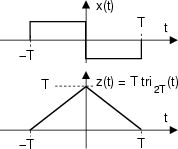Le ultime due proprietà riguardano un risultato di applicazione meno frequente, ma talvolta utile. Si ottiene infatti che le operazioni di derivata ed integrale di un segnale possono essere realizzate mediante il passaggio dello stesso attraverso un sistema fisico, in quanto tali operazioni nel tempo sono equivalenti a dei prodotti in frequenza, realizzabili in forma di convoluzione del segnale per una risposta impulsiva.
E' equivalente a moltiplicare lo spettro per j2![]() f:
f:
L'andamento dello spettro originario
X![]() f
f![]() risulta esaltato
alle frequenze più elevate, in quanto il suo modulo è moltiplicato per
2
risulta esaltato
alle frequenze più elevate, in quanto il suo modulo è moltiplicato per
2![]()
![]() f
f![]() ,
dato che
,
dato che
![]() Z
Z![]() f
f![]()
![]() =
= ![]() 2
2![]() f
f![]() .
. ![]() X
X![]() f
f![]()
![]() .
La fase, invece, subisce un incremento di
.
La fase, invece, subisce un incremento di
![]() a tutte le frequenze
(il numero immaginario puro
j2
a tutte le frequenze
(il numero immaginario puro
j2![]() f = 2
f = 2![]() f ej
f ej![]() ha fase
ha fase
![]() ).
).
Si ottiene:
X![]() f
f![]() =
= ![]()
![]()
![]()
![]() f - f1
f - f1![]() +
+ ![]()
![]() f + f1
f + f1![]() +
+ ![]()
![]() f - f2
f - f2![]() +
+ ![]()
![]() f + f2
f + f2![]()
![]() .
Dato che
.
Dato che
f . ![]()
![]() f - a
f - a![]() = a .
= a . ![]()
![]() f - a
f - a![]() , risulta:
, risulta:
Considerando ora che
j2![]()
![]() = -
= - ![]() , si ottiene
y
, si ottiene
y![]() t
t![]() = - 2
= - 2![]() f1sin
f1sin![]() t - 2
t - 2![]() f2sin
f2sin![]() t
e quindi, per f1 = 10 e f2 = 100, si ha
t
e quindi, per f1 = 10 e f2 = 100, si ha
E' equivalente a dividere lo spettro per j2![]() f:
f:
In questo caso, le basse frequenze del segnale originario sono esaltate seguendo
un andamento
1/2![]()
![]() f
f![]() , mentre la fase subisce una variazione
(un ritardo) costante pari a
-
, mentre la fase subisce una variazione
(un ritardo) costante pari a
- ![]() . Notiamo come questo risultato
determini una singolarità per f = 0 in presenza di componenti continue
per
x
. Notiamo come questo risultato
determini una singolarità per f = 0 in presenza di componenti continue
per
x![]() t
t![]() : in tal caso infatti il suo integrale tende a divergere
e non è più di energia.
: in tal caso infatti il suo integrale tende a divergere
e non è più di energia.

ed il suo integrale
entrambi rappresentati in figura:
z![]() t
t![]() è nullo
fino a t < - T, cresce linearmente fino a t = 0, e quindi il contributo
all'integrale dato dall'area del rect negativo torna ad annullarne il
valore.
è nullo
fino a t < - T, cresce linearmente fino a t = 0, e quindi il contributo
all'integrale dato dall'area del rect negativo torna ad annullarne il
valore.
Per calcolare la
![]() -trasformata di
z
-trasformata di
z![]() t
t![]() ,
calcoliamo prima quella di
x
,
calcoliamo prima quella di
x![]() t
t![]() , e poi applichiamo la proprietà
dell'integrazione. Applicando la proprietà di traslazione nel tempo, scriviamo
, e poi applichiamo la proprietà
dell'integrazione. Applicando la proprietà di traslazione nel tempo, scriviamo
| X |
= | Tsinc |
| = | j2T |
Dividendo quindi per j2![]() f si ottiene
f si ottiene
il cui andamento è mostrato in figura 3.4
.Lo stesso risultato può essere ottenuto per altra via, notando che